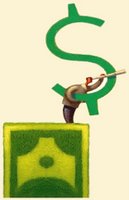2012 Prime Rate Forecast: Prime Very Likely To Remain At 3.25% All Year
 Since August 9, 2011, the Federal Open Market Committee (FOMC) has included the following language in each post-monetary-policy-meeting press release:
Since August 9, 2011, the Federal Open Market Committee (FOMC) has included the following language in each post-monetary-policy-meeting press release:"...The Committee currently anticipates that economic conditions -- including low rates of resource utilization and a subdued outlook for inflation over the medium run -- are likely to warrant exceptionally low levels for the federal funds rate at least through mid-2013..."This means that the U.S. Prime Rate, which is the fed funds target rate plus 3 points, is very unlikely to rise during all of 2012. And, of course, Prime can't go any lower since, at 3.25%, it's already at rock bottom.
America's central bank is unique in that it has a dual mandate: keep prices stable and keep the unemployment rate as low as possible (maximum employment.) If the Fed were like many other central banks that only have to worry about keeping prices stable, then there is no way it could send such a powerful, long term signal to markets (near-zero rates for 2 years.) However, Congress decided to complicate the Fed's mission by making it a pseudo-political organization, and that's the way it is. When 200,000+ jobs are being created month after month, then the Fed will start thinking about raising short-term interest rates. Until then, it's cheap money for American banks, businesses, credit-card borrowers, etc.
So, you savers out there who are tired of extremely weak returns on your saving accounts and CD's: don't blame Ben Bernanke. He's just doing what he's supposed to do, according to the Fed's mandate.
Mortgage Rates
The Fed doesn't control mortgage rates like it does the Prime Rate. Rates on 30-year, fixed-rate mortgages track very closely with the yield on the 10 Year US Treasury Note.
But since:
- economic growth is probably going to remain tepid for many more months, and
- inflation expectations are tame, and
- Wall Street money continues to be very keen on finding shelter under the copper roof that is US government debt
mortgage rates are likely to remain extremely favorable for solid borrowers during 2012.
The Ten-Year Treasury yield was 3.31% at the end of 2010. It ended 2011 @ 1.87%.
Mortgage behemoth Freddie Mac recently reported that the average rate on a 30-year, fixed-rate mortgage ended 2011 @ a very homebuyer friendly 3.95%.
From the entire gang here @ www.FedPrimeRate.com: All the best for 2012.
--
As of right now, the investors who trade in fed funds futures at the Chicago Board of Trade have odds at 100% (as implied by current pricing on contracts) that the Federal Open Market Committee (FOMC) will vote to leave the benchmark target range for the Federal Funds Rate at its current level at the January 25TH, March 13TH and April 25TH, 2012 FOMC monetary policy meetings.
Summary of the Latest Prime Rate Forecast:
- Current odds that the Prime Rate will remain at the current 3.25% after the January 25TH, March 13TH and April 25TH FOMC monetary policy meetings are adjourned: 100% (certain)
- NB: U.S. Prime Rate = (The Federal Funds Target Rate + 3)
The odds related to federal-funds futures contracts -- widely accepted as the best predictor of where the FOMC will take the benchmark Fed Funds Target Rate -- are constantly changing, so stay tuned for the latest odds.
Labels: 2012, mortgage, mortgage_rate_prediction, mortgage_rates, odds, prime_rate_forecast, prime_rate_prediction
|
--> www.FedPrimeRate.com Privacy Policy <--
--> www.FedPrimeRate.com Privacy Policy -- BACKUP<-- CLICK HERE to JUMP to the TOP of THIS PAGE > SITEMAP < |



<< Home